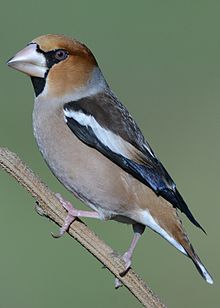| Hawfinch | |
|---|---|

| |
| Male in winter | |
| Scientific classification | |
| Domain: | Eukaryota |
| Kingdom: | Animalia |
| Phylum: | Chordata |
| Class: | Aves |
| Order: | Passeriformes |
| Family: | Fringillidae |
| Subfamily: | Carduelinae |
| Genus: | Coccothraustes Brisson, 1760 |
| Species: | C. coccothraustes
|
| Binomial name | |
| Coccothraustes coccothraustes (Linnaeus, 1758)
| |

| |
| Ranges of C coccothraustes Breeding Resident Non-breeding
| |
| Synonyms | |
|
Loxia coccothraustes Linnaeus, 1758 | |

The hawfinch (Coccothraustes coccothraustes) is a passerine bird in the finch family Fringillidae. It is the only species placed in the genus Coccothraustes. Its closest living relatives are the Chinese grosbeak (Eophona migratoria) and Japanese grosbeak (Eophona personata) of East Asia, the evening grosbeak (Hesperiphona vespertina) of North America, and hooded grosbeak (Hesperiphona abeillei) of Central America.
This bird breeds across Europe and temperate Asia (Palearctic). It is mainly resident in Europe, but many Asian birds migrate further south in the winter. It is a rare vagrant to the western islands of Alaska.
Deciduous or mixed woodland, including parkland, with large trees – especially hornbeam – is favoured for breeding. The hawfinch builds its nest in a bush or tree, and lays 2–7 eggs. The food is mainly seeds and fruit kernels, especially those of cherries, which it cracks with its powerful bill. This large finch species is usually seen in a pair or small group.
The 16.5–18 cm long hawfinch is a bulky bull-headed bird, which appears very short-tailed in flight. Its head is orange-brown with a black eyestripe and bib, and a massive bill, which is black in summer but paler in winter. The upper parts are dark brown and the underparts orange.
The white wing bars and tail tip are striking in flight. The sexes are similar. The call is a hard chick. The song of this unobtrusive bird is quiet and mumbled.
- ^ BirdLife International (2017). "Coccothraustes coccothraustes". IUCN Red List of Threatened Species. 2017: e.T22720681A111132393. doi:10.2305/IUCN.UK.2017-1.RLTS.T22720681A111132393.en. Retrieved 12 November 2021.
